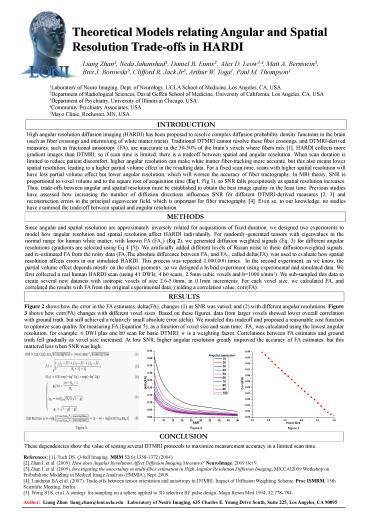Theoretical Models relating Angular and Spatial Resolution Trade-offs in HARDI
Title:
Theoretical Models relating Angular and Spatial Resolution Trade-offs in HARDI
Description:
Theoretical Models relating Angular and Spatial Resolution Trade-offs in HARDI Liang Zhan1, Neda Jahanshad1, Daniel B. Ennis2 , Alex D. Leow3,4, Matt A. Bernstein5 ... –
Number of Views:54
Avg rating:3.0/5.0
Title: Theoretical Models relating Angular and Spatial Resolution Trade-offs in HARDI
1
Theoretical Models relating Angular and Spatial
Resolution Trade-offs in HARDI
Liang Zhan1, Neda Jahanshad1, Daniel B. Ennis2 ,
Alex D. Leow3,4, Matt A. Bernstein5, Bret J.
Borowski5, Clifford R. Jack Jr5, Arthur W. Toga1,
Paul M. Thompson1
1Laboratory of Neuro Imaging, Dept. of Neurology,
UCLA School of Medicine, Los Angeles, CA,
USA 2Department of Radiological Sciences, David
Geffen School of Medicine, University of
California, Los Angeles, CA, USA 3Department of
Psychiatry, University of Illinois at Chicago,
USA 4Community Psychiatry Associates, USA 5Mayo
Clinic, Rochester, MN, USA
INTRODUCTION
High angular resolution diffusion imaging (HARDI)
has been proposed to resolve complex diffusion
probability density functions in the brain (such
as fiber crossings and intermixing of white
matter tracts). Traditional DTMRI cannot resolve
these fiber crossings, and DTMRI-derived
measures, such as fractional anisotropy (FA), are
inaccurate in the 30-50 of the brains voxels
where fibers mix 1. HARDI collects more
gradient images than DTMRI, so if scan time is
limited, there is a tradeoff between spatial and
angular resolution. When scan duration is limited
to reduce patient discomfort, higher angular
resolution can make white matter fiber-tracking
more accurate, but this also means lower spatial
resolution, leading to a higher partial volume
effect in the resulting data. For a fixed scan
time, scans with higher spatial resolution will
have less partial volume effect but lower angular
resolution, which will worsen the accuracy of
fiber tractography. In MRI theory, SNR is
proportional to voxel volume and to the square
root of acquisition time (Eq 1, Fig 1), so SNR
falls precipitously as spatial resolution
increases. Thus, trade-offs between angular and
spatial resolution must be established to obtain
the best image quality in the least time.
Previous studies have assessed how increasing the
number of diffusion directions influences SNR for
different DTMRI-derived measures 2, 3 and
reconstruction errors in the principal
eigenvector field, which is important for fiber
tractography 4. Even so, to our knowledge, no
studies have examined the trade-off between
spatial and angular resolution.
METHODS
Since angular and spatial resolution are
approximately inversely related for acquisitions
of fixed duration, we designed two experiments to
model how angular resolution and spatial
resolution affect HARDI individually. For
randomly-generated tensors with eigenvalues in
the normal range for human white matter, with
known FA (FA1) (Eq 2), we generated diffusion
weighted signals (Eq. 3) for different angular
resolutions (gradients are selected using Eq 4
5). We artificially added different levels of
Rician noise to these diffusion-weighted signals,
and re-estimated FA from the noisy data (FA2The
absolute difference between FA1 and FA2, called
delta(FA), was used to evaluate how spatial
resolution affects errors in our simulated HARDI.
This process was repeated 1,000,000 times. In
the second experiment, as we know, the partial
volume effect depends mostly on the object
geometry, so we designed a hybrid experiment
using experimental and simulated data. We first
collected a real human HARDI scan (using 41 DWIs,
4 b0 scans, 2.5mm cubic voxels and b1000 s/mm2).
We sub-sampled this data to create several new
datasets with isotropic voxels of size 2.6-5.0mm,
in 0.1mm increments. For each voxel size, we
calculated FA, and correlated the results with FA
from the original experimental data, yielding a
correlation value, corr(FA).
RESULTS
Figure 2 shows how the error in the FA estimates,
delta(FA), changes (1) as SNR was varied, and (2)
with different angular resolutions. Figure 3
shows how corr(FA) changes with different voxel
sizes. Based on these figures, data from larger
voxels showed lower overall correlation with
ground truth, but still achieved a relatively
small absolute error (delta). We modeled this
tradeoff and proposed a reasonable cost function
to optimize scan quality for measuring FA
(Equation 5), as a function of voxel size and
scan time FAo was calculated using the lowest
angular resolution, for example 6 DWI plus one
b0 scan for basic DTMRI w is a weighting factor.
Correlations between FA estimates and ground
truth fell gradually as voxel size increased. At
low SNR, higher angular resolution greatly
improved the accuracy of FA estimates, but this
mattered less when SNR was high.
CONCLUSION
These dependencies show the value of testing
several DTMRI protocols to maximize measurement
accuracy in a limited scan time.
References 1. Tuch DS. Q-ball Imaging. MRM
52(6)1358-1372 (2004). 2.Zhan L et al. (2009).
How does Angular Resolution Affect Diffusion
Imaging Measures? NeuroImage, 2009 Oct
9. 3.Zhan L et al. (2009). Investigating the
uncertainty in multi-fiber estimation in High
Angular Resolution Diffusion Imaging, MICCAI2009
Workshop on Probabilistic Modeling in Medical
Image Analysis (PMMIA), Sept. 2009. 4. Landman
BA et al. (2007). Trade-offs between tensor
orientation and anisotropy in DTMRI Impact of
Diffusion Weighting Scheme. Proc ISMRM, 15th
Scientific Meeting, Berlin. 5. Wong STS, et al.
A strategy for sampling on a sphere applied to 3D
selective RF pulse design. Magn Reson Med 1994
32778784.
Author Liang Zhan liang.zhan_at_loni.ucla.edu
Laboratory of Neuro Imaging, 635 Charles E. Young
Drive South, Suite 225, Los Angeles, CA 90095































